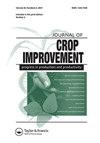Empirical modeling of the impact of climate change on altitudinal shift of major cereal crops in South Tigray, Northern Ethiopia
IF 1.5
Q3 AGRONOMY
引用次数: 4
Abstract
ABSTRACT Climate change is expected to alter the growing conditions of agricultural crops. With increasing surface temperature, future suitable areas for crop production will see an altitude shift. Such shift is an adaptation response of crops to climate change. However, in the study area there are a limited number of studies that have dealt with geographical shifts of crops caused by climate change. This study was conducted with the aim of assessing impacts of climate change on altitudinal migration of crops and length of growing period (LGP). The climate and crop modeling study were carried out using ArcGIS, Diva GIS and MaxEnt using 30 years of climate data for the period 1980 to 2009. Results showed that wheat (Triticum aestivum) and barley (Hordeum vulgare L.) would migrate upward along the altitudinal gradients in the coming 80 years. However, areas under these crops are expected to drop by 16–100%. Highly impacted areas are expected to increase, whereas low impacted and new suitable areas are expected to decline significantly. Suitable areas for sorghum (Sorghum bicolor) and teff (Eragrostis tef Zucc.) production are expected to increase. While wheat and barley are projected to be highly affected by future climate change, sorghum and teff should be relatively stable. No significant difference was observed in LGP between the considered RCP 2.6 and RCP 8.5 climate scenarios. Therefore, this study concluded that upward movement of crops was one mechanism to adapt to climate change, and new varieties resilient to future climate change needs to be developed.气候变化对埃塞俄比亚北部提格雷南部主要谷物作物海拔变化影响的经验模型
气候变化将改变农作物的生长条件。随着地表温度的升高,未来适合作物生产的地区将出现海拔的变化。这种变化是农作物对气候变化的适应性反应。然而,在研究区域内,处理气候变化引起的作物地理变化的研究数量有限。本研究旨在评估气候变化对作物纵向迁移和生长期的影响。利用ArcGIS、Diva GIS和MaxEnt对1980 - 2009年30年的气候数据进行了气候和作物模型研究。结果表明,小麦(Triticum aestivum)和大麦(Hordeum vulgare L.)在未来80年将沿海拔梯度向上迁移。然而,种植这些作物的面积预计将减少16-100%。高受影响地区预计会增加,而低受影响地区和新的适宜地区预计会大幅减少。适合高粱(sorghum bicolor)和苔麸(Eragrostis tef Zucc.)生产的地区预计会增加。虽然小麦和大麦预计将受到未来气候变化的严重影响,但高粱和苔麸应该相对稳定。在考虑的RCP 2.6和RCP 8.5气候情景之间,LGP未观察到显著差异。因此,本研究认为作物向上运动是适应气候变化的机制之一,需要开发适应未来气候变化的新品种。
本文章由计算机程序翻译,如有差异,请以英文原文为准。
求助全文
约1分钟内获得全文
求助全文
来源期刊

Journal of Crop Improvement
Multiple-
CiteScore
3.30
自引率
7.70%
发文量
42
期刊介绍:
Journal of Crop Science and Biotechnology (JCSB) is a peer-reviewed international journal published four times a year. JCSB publishes novel and advanced original research articles on topics related to the production science of field crops and resource plants, including cropping systems, sustainable agriculture, environmental change, post-harvest management, biodiversity, crop improvement, and recent advances in physiology and molecular biology. Also covered are related subjects in a wide range of sciences such as the ecological and physiological aspects of crop production and genetic, breeding, and biotechnological approaches for crop improvement.
 求助内容:
求助内容: 应助结果提醒方式:
应助结果提醒方式:


